
 |
|
|
|
|
#1 |
|
Vikingsword Staff
Join Date: Dec 2004
Location: The Aussie Bush
Posts: 4,610
|
The link to which Rick referred has been changed and the article can now be found here:
http://sevenstarstrading.com/article...n%20Aborigines There are also three old threads with much information about other types of Taiwanese swords, and they are here: http://www.vikingsword.com/ubb/Forum1/HTML/000582.html http://www.vikingsword.com/ubb/Forum1/HTML/000858.html http://www.vikingsword.com/ubb/Forum1/HTML/002486.html Ian. |
|
|

|
|
|
#2 |
|
Vikingsword Staff
Join Date: Nov 2004
Posts: 6,378
|
Thank you Ian .
|
|
|

|
|
|
#3 |
|
Member
Join Date: Sep 2005
Location: Ex-Taipei, Taiwan, now in Shanghai, China
Posts: 180
|
As I suggested in my second post on the swapforum, you will find a lot of informations on taiwanese tribes on Wikipedia. For more precise questions, no problem it's my pleasure to answer if I can. Rick, your sword is in fact from Taiwan. It is from the Rukai tribe and If I'm not mistaking should be a little over 50cm long. The Rukai and the Puyuma are two sub-groups of the Paiwan. They share a lot of common things with the Paiwan but still have their own particularities. They are living in the southern mountains of the island (if you have a good atlas, they are in the mountains 20 to 30 km away from the southern city of Pingtung) and are around 10 000 thousands today (the Paiwan proper are around 60 000 and the Puyuma, 10 000). These three tribes are mountain or hill tribes (by opposition with some other lowland or plain tribes of Taiwan). They were fierce headhunters, in a ritual purpose. They were among the last with the Bunun and the Atayal to fight against the Japanese before they were "pacified" in the twenties. But still some case of head huntings were reported at the end of the fourties. They were among the best soldiers when they fought in the rank of the Japanese army in the Pacific war (Taiwan was a japanese colony at that time and the aborigines considered themselves, after their pacification, as loyal subjects of the Emperor). They were very well known as military scouts, and if I don't mistake one of the last lost japanese soldiers to reappear from the jungle of South East Asia in the 70's was in fact a taiwanese aborigine. Concerning the swords or knives, the Paiwan (and the sub-groups which the Rukai are among) and the Yami that inhabits the Orchid Island (Lanyu in chinese, Botel Tobago former name), that are very well known for their pirogues, adorns their sheaths with motives. In the case of the Rukai, like on your sword, Rick, the serpent is fundamental as it is reprensenting the main ancestor of the tribe, a pattern that can be found on nearly every Paiwan objects.
|
|
|

|
|
|
#4 |
|
Vikingsword Staff
Join Date: Dec 2004
Location: The Aussie Bush
Posts: 4,610
|
Yuanzhumin:
Would you also care to identify the tribal origins of the following swords and knives? Example A: This one is from the collection of the distinguished host of this web site, Dr. Lee Jones, who posted the following pictures in 2001. OAL 28.75 inches (73 cm) 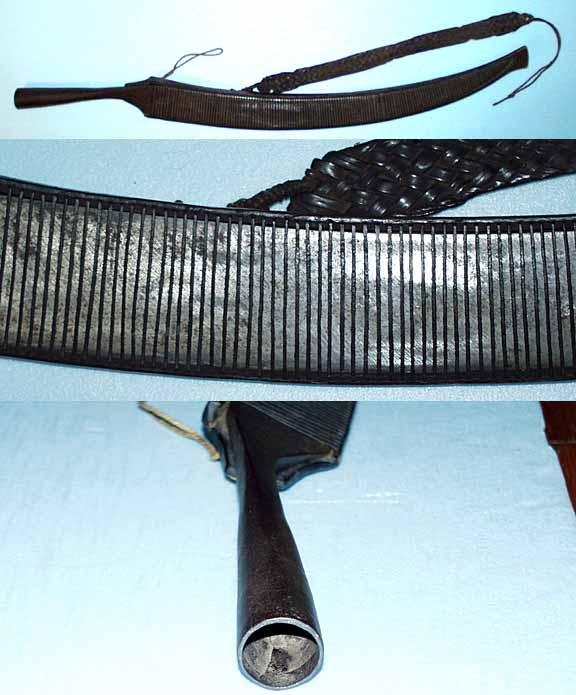 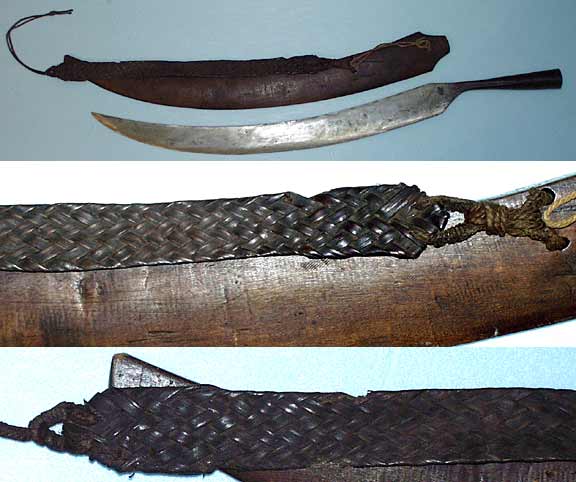 Examples B,C,D: These are from my own collection. B: OAL 19.75 inches. (50 cm) C: OAL 24 inches. (61 cm) D: OAL 34 inches (86 cm -- the largest of this style I have seen)  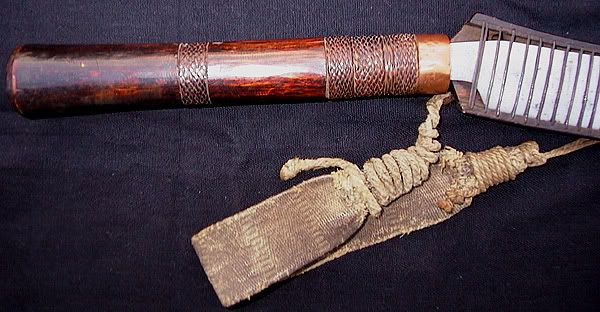  Example E: Another one of mine 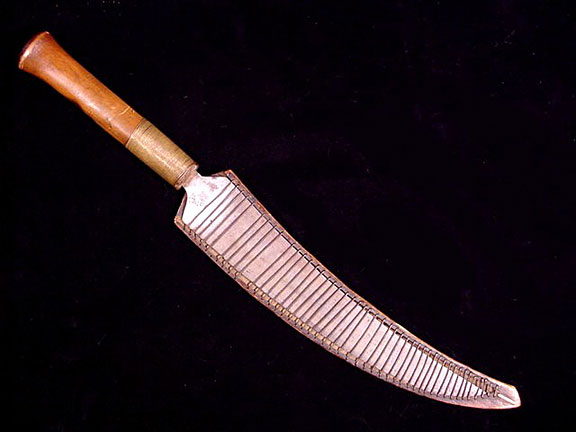 Thanks for any additional information you may have. Ian. Last edited by Ian; 17th September 2005 at 05:35 PM. Reason: Added dimensions in cm |
|
|

|
|
|
#5 |
|
Member
Join Date: Dec 2004
Location: What is still UK
Posts: 5,935
|
This is my one, sorry the picture is not very good. I am having peoblems with my camera wizard loading and editting program. This is the only one of these I have seen in the UK since I have been collecting. It was only through this site that I found out it was from Formosa. The total length of the blade and handle is 59 cm. Tim
Last edited by Tim Simmons; 17th September 2005 at 04:31 PM. Reason: adding more pictures |
|
|

|
|
|
#6 |
|
Member
Join Date: Dec 2004
Location: What is still UK
Posts: 5,935
|
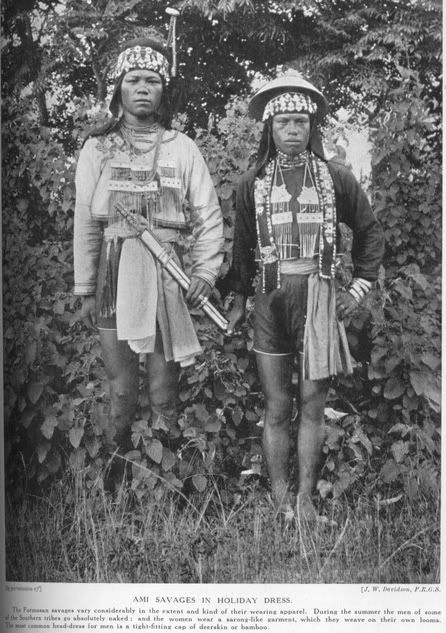
|
|
|

|
|
|
#7 |
|
Member
Join Date: Dec 2004
Location: What is still UK
Posts: 5,935
|

|
|
|

|
|
|
#8 |
|
Member
Join Date: Sep 2005
Location: Ex-Taipei, Taiwan, now in Shanghai, China
Posts: 180
|
I'm happy and flattered to have created such an interest in Taiwanese knives. Congratulations to all of you that showed me pictures ! You have all very nice knives from Taiwan. If one day you want to depart from them, don't forget to tell me first ! http://www.vikingsword.com/vb/images/icons/icon12.gif
 Well, I don't know from where to begin. Well, I don't know from where to begin. The first that was shown to me (Rick's one) was from the Rukai tribe, one of the Paiwan sub-group in the south of the island. It was straight, and straight is the way to recognise between the southern tribes' knives and the northern' ones. All the knives you have shown me after Rick's one are curved (even if it is slightly), so they are from the northern tribes. The common point to all the taiwanese tribes knives (southern, central and northern) is the one-sided sheaths and no guards. -So this is for Ian : Example A: you have a nice Atayal knife. I love the 'naked handle'. It is so modern and design ! Example B and D : These are nice Bunun or Tsou knives. These are the central tribes. Their knives are not as curved as the Atayal and not straight like the Paiwan. The two tribes are very close, and their knives (and other cultural traditions) difficult sometimes to distinguish. The Bunun are the most mountainous of the Taiwanese tribes, living at the highest altitude, considering the Yushan (formerly known as Mount Morrison) as a sacred mountain. The Yushan (close to 4000 m high) is one of the highest peak in South East Asia. C and D : Two other nice Atayal knives. The D is original for its length as you said, Ian, as usually the 'standard length' is between 50 and 60cm. -This is for Tim : Your knife has very nice proportions, the shape of the sheath is in the best Atayal style, beautiful... except one important thing : Atayal knives, I mean their sheathes, are not colored. I'm sure, without looking carefully at the red pigments I see on it, that this is not tribal painting but chemical painting done later. The Atayal are the principal group of the northern tribes. They are formed of three sub-groups : the Atayal proper, the Truku (Taroko) and the Seedeq. They are very close in their cultural traditions but still have enough differences, mostly in the language (half the same). The Atayal are today something like 60 000. The Atayal women are the best weavers and dressmakers of all the taiwanese tribes and they are renowned for their shellbeads clothes or shellbead jewellery.The Atayal, in opposition to the Paiwan groups, don't sculpt or carve the wood. So when the Rukai sheath is full of motives, like Rick's knife, the Atayal have none. But I would say that their beauty is not in the details but in the shape. Look at these blades slightly curved, the handles and the blades being one (example A from Ian and the one from Tim)! Their simplicity, purety is so modern. Even today the best designers with all their computers would not create a better balanced shape. Look at the sheath with the knife inside, it is not carved on it, but the whole together is like a sculpture. The sheath of the Atayal knife has the shape of a fish jumping out of the water, with the top bottom of the sheath being the tail and, on the middle edge of some sheathes (see the one from Tim), a kind of "back" fin, very slight, nearly invisible but so classy. Well, sorry for being so long ! |
|
|

|
|
|
#9 |
|
Vikingsword Staff
Join Date: Dec 2004
Location: The Aussie Bush
Posts: 4,610
|
Yuanzhumin:
Thank you for the prompt and informative responses. I think there are several people here who have collected these knives over the years. Apart from the book, Material Culture of the Formosan Aborigines by Professor Chen Chi-Lu, I have found very little to describe these swords and knives. The older ones I have handled have been uniformly well made with well forged blades, and sheaths that have been carved and fitted to the knives with considerable skill. There are, of course, modern "interpretations" which seem to have been made for the tourist industry. These come up from time to time on eBay and are usually mislabeled as "African" because of the animalistic carvings to the sheath and handles. I have seen both straight and curved varieties of these modern knives and swords, none of which have the quality of older pieces. Can you shed any light on whether knives and swords are still being made in the traditional manner by the respective Taiwanese aboriginal groups? Ian. |
|
|

|
|
|
#10 | |
|
Member
Join Date: Dec 2004
Posts: 951
|
Quote:
I don t think this is formosa Tim you can find an pic in the National geographic magazine from september 1912 page 854 . Ilongot it might be . Ben |
|
|
|

|
|
|
#11 |
|
Member
Join Date: Dec 2004
Location: What is still UK
Posts: 5,935
|
Ben,
I am happy to believe you, but would need a picture, otherwise I will have to go with the information and examples we have here from this site. post the picture please 
|
|
|

|
 |
|
|